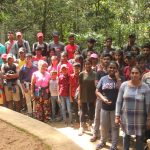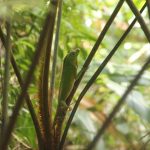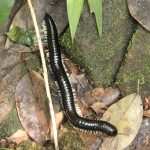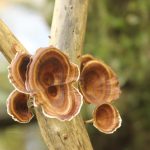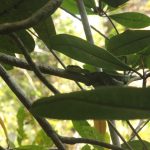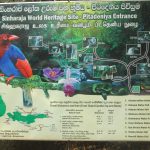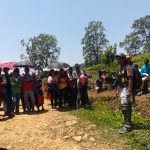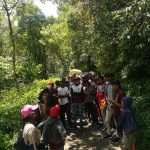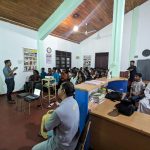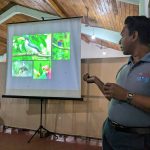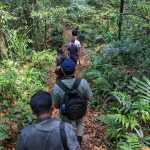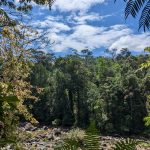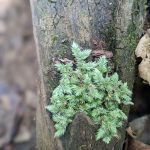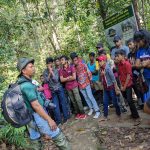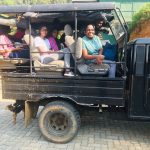Climate change is an inherent social issue that can upset anyone’s life in countless ways. Climate change is causing different social, economic, and public health issues on all the communities around the world. Therefore, advocating for climate justice by the local communities is the most essential solution to this worsening scenario. On that note, ‘Stepping Stone to Safeguarding Sri Lanka’s Natural Environment’ (SSEP) was implemented by Caritas Sri Lanka (CSL) with the funding support of Misereor in January 2022.The goal of the project is to advocate for solutions and to create awareness especially, among the grassroots level communities who are affected by the climate change environmental issues.
As a first step of implementing SSEP in the entire island, environmental adult, youth and children groups were formed by the 13 Dioceses of Caritas. 156 environmental groups were formed at the end of 2022 with the goal of creating environmentally conscious adults, youth and children under this project. SSEP is currently in its second phase, and several development activities & awareness-creation workshops are being undertaken by Caritas Diocesan Centers in Sri Lanka. On that note, an educational exposure tour to the Sinharaja rainforest was organized by Caritas Anuradhapura for 50 members of the environmental youth groups and another 10 members of the adult groups on the 5th & 6th of March 2023.
Sri Lanka is an island nation, which exhibits a wide array of ecosystems ranging from forest to agricultural, aquatic and marine environments. Despite its small size, Sri Lanka exhibits remarkable biological diversity and is considered to be the best bio diversity hotspot in the Asian region in terms of species concentration. Specific forest types including rainforests, dry zone monsoon forests and arid thorn scrub forests characterize the several climate zones that exist in the country. Hence, the Sinharaja rainforest is the country’s last viable area of primary tropical rainforest and a biodiversity hotspot, which is located in the Southwest lowland wet zone within Sabaragamuwa & Southern Provinces of Sri Lanka.
The entire forest covers an area of 8,864 ha of primary and secondary forests, which lies between the tributaries of the Kalu Ganga in the North and the Gin Ganga in the South. Sinharaja forest was accepted by UNESCO as a biosphere reserve in 1978. The forest is made of 60% rare endemic trees and this forest is a home to many endemic wildlife such as birds, mammals, many kinds of insects, reptiles, rare amphibians and butterflies. Considering all the ecological importance of the forest, UNESCO declared Sinharaja forest as a UNESCO World Heritage in 1988 under the name of the Sinharaja forest reserve. Sinharaja rainforest is the habitat for rare and endangered species and an outstanding site for studying the process of biological evolution.
This educational exposure visit was organized for the youth to make them aware of the best bio diversity hotspot available for Sri Lankans and to educate them of the different ecosystems that exist in the country. Rev.Fr. Bennette Mellawa the Director of Caritas Anuradhapura took responsibility for the entire exposure tour. Mr. Sujeewa Chamikara, a well-known environmentalist from MONLAR (Movement for Land and Agricultural Reforms) joined in to educate the participants.
During the visit, he explained the importance of preserving the ecosystems which has a direct impact on the lives of every living being on earth. Mr. Chamikara took the lead role of guiding the participants inside the forest and explained what participants witnessed during their visit to the forest from organisms to the ecosystems. A glimpse of the rain forest and the ecosystem with its insects, reptiles, mammals etc, was introduced to the students with their scientific names.
He also instructed the participants not to make noise while in the forest, as that would force the animals to move away from the walking paths. The participants were divided into 05 groups to build unity & responsibility among students during their 2-day exposure tour. Each team had to mention their objectives of the visit and share their ideas of the rainforest, ecosystems witnessed and learned.
Day one (05/03/2023) was a fulfilling day for all the participants. The team entered the forest through the Pitadeniya entrance, which is located about 15 km away from Deniyaya town in Galle district. This entrance is also known as one of the most active entrances over the years because of Kekuna Ella waterfall, Pathan Oya waterfall and the hanging bridge in Pitadeniya Conservation Center. A journey of 14 Km which includes both walking & hiking, the participants took nearly 08 hours to complete the journey. Students were able to see many rare species such as ferns, endemic plants like hora, and endemic vertebrates such as green pit viper, hump nosed lizard, kangaroo lizard, black grizzled giant squirrel, endemic fish varieties like Ceylonese Combtail, and many types of bird varieties. They also witnessed many endemic invertebrates such as giant earthworms, giant land snails, Sri Lankan giant millipedes, black caterpillar, endemic leeches during their exposure visit inside the forest on the day one.
Mr. Chamikara helped the participants to identify variety of reptiles, mammals, and birds. He also explained about special adaptations that the wild animals gained over the years of evolution to catch their prey and to live in highly dense forests. With regard to the plants and trees, the environmentalist explained how trees help the forest to maintain the stability of the ecosystem and he also mentioned adaptations that some trees have gained to spread their seeds and stratification of trees in a tropical rainforest. Students were also able to experience natural fish therapy at Gal Oruwa waterfall, Thattu waterfall and Pathan oya waterfall inside the forest. It was a thrilling experience for many of them.
Day two (06/03/2023) was an adventure visit. Students were taken to the Deniyaya, Kurulugala entrance of the forest which is located 900m above the sea level via a safari ride nearly about 10 Km up in the hill. Kurulugala entrance is one of the ideal places in Sinharaja rainforest reserve for bird watching and butterfly watching. A journey of 10 Km, which includes both hiking and walking, took 5 hours to complete the exposure visit on day two. Students were able to see some varieties of butterflies such as tree nymph, small grass yellow butterfly, some varieties of birds such as blue magpie, spot winged thrust, white faced starling, woodpecker, caterpillars, rare varieties of monkeys, the smallest tree in the forest which is known as ‘Vana raja’, ferns, a rare variety of rock, and some mollusks.
Mr. Chamikara also explained how his organization MONLAR campaigned against the road expansion inside Sinharaja forest area at ‘Gongala’. He further explained how such development work could cause negative impacts on the forest eco systems. He said, “We protested against the expansion mainly due to the fact that the particular reserved forest area has the highest number of endemic species; hence any development activity can disturb or destroy the normal life of the entire eco-systems of the forest”. Furthermore, he narrated why a forest like Sinharaja should be protected by all of us, stressing the importance of conserving the wildlife and its habitat. He said that we all have the responsibility to conserve the entire island and its nature.
With this, the entire exposure visit came to an end. The participants thanked Fr. Benet, Mr. Chamika the environmentalist and the Caritas Anuradhapura team for organizing such an eye opening tour and said that they will never forget these 3 days in their lives.


